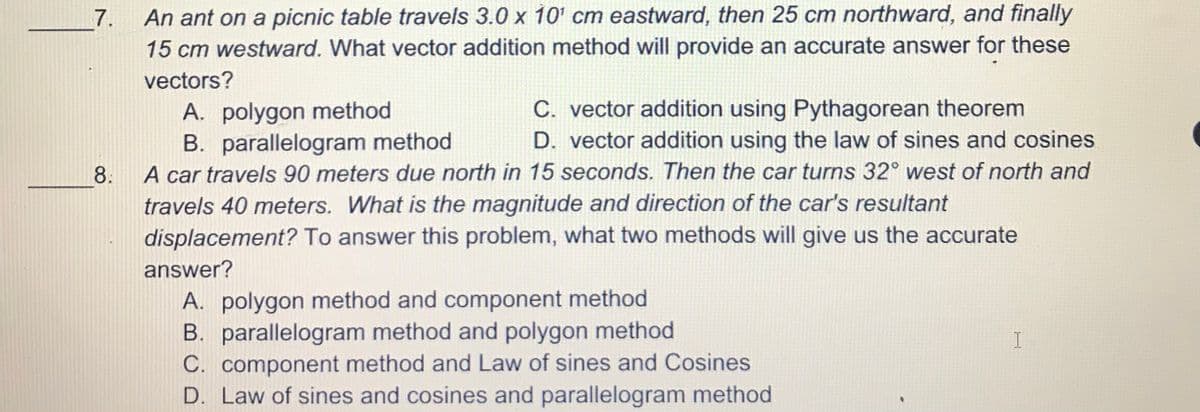An ant on a picnic table travels 3.0 x 10' cm eastward, then 25 cm northward, and finally 15 cm westward. What vector addition method will provide an accurate answer for these vectors? A. polygon method B. parallelogram method A car travels 90 meters due north in 15 seconds. Then the car turns 32° west of north and C. vector addition using Pythagorean theorem D. vector addition using the law of sines and cosines
An ant on a picnic table travels 3.0 x 10' cm eastward, then 25 cm northward, and finally 15 cm westward. What vector addition method will provide an accurate answer for these vectors? A. polygon method B. parallelogram method A car travels 90 meters due north in 15 seconds. Then the car turns 32° west of north and C. vector addition using Pythagorean theorem D. vector addition using the law of sines and cosines
Physics for Scientists and Engineers: Foundations and Connections
1st Edition
ISBN:9781133939146
Author:Katz, Debora M.
Publisher:Katz, Debora M.
Chapter3: Vectors
Section: Chapter Questions
Problem 65PQ
Related questions
Question

Transcribed Image Text:7. An ant on a picnic table travels 3.0 x 10' cm eastward, then 25 cm northward, and finally
15 cm westward. What vector addition method will provide an accurate answer for these
vectors?
A. polygon method
B. parallelogram method
A car travels 90 meters due north in 15 seconds. Then the car turns 32° west of north and
C. vector addition using Pythagorean theorem
D. vector addition using the law of sines and cosines
8.
travels 40 meters. What is the magnitude and direction of the car's resultant
displacement? To answer this problem, what two methods will give us the accurate
answer?
A. polygon method and component method
B. parallelogram method and polygon method
C. component method and Law of sines and Cosines
D. Law of sines and cosines and parallelogram method
Expert Solution
This question has been solved!
Explore an expertly crafted, step-by-step solution for a thorough understanding of key concepts.
This is a popular solution!
Trending now
This is a popular solution!
Step by step
Solved in 2 steps with 2 images

Recommended textbooks for you

Physics for Scientists and Engineers: Foundations…
Physics
ISBN:
9781133939146
Author:
Katz, Debora M.
Publisher:
Cengage Learning

Physics for Scientists and Engineers, Technology …
Physics
ISBN:
9781305116399
Author:
Raymond A. Serway, John W. Jewett
Publisher:
Cengage Learning

College Physics
Physics
ISBN:
9781938168000
Author:
Paul Peter Urone, Roger Hinrichs
Publisher:
OpenStax College

Physics for Scientists and Engineers: Foundations…
Physics
ISBN:
9781133939146
Author:
Katz, Debora M.
Publisher:
Cengage Learning

Physics for Scientists and Engineers, Technology …
Physics
ISBN:
9781305116399
Author:
Raymond A. Serway, John W. Jewett
Publisher:
Cengage Learning

College Physics
Physics
ISBN:
9781938168000
Author:
Paul Peter Urone, Roger Hinrichs
Publisher:
OpenStax College

Principles of Physics: A Calculus-Based Text
Physics
ISBN:
9781133104261
Author:
Raymond A. Serway, John W. Jewett
Publisher:
Cengage Learning

Physics for Scientists and Engineers
Physics
ISBN:
9781337553278
Author:
Raymond A. Serway, John W. Jewett
Publisher:
Cengage Learning

Physics for Scientists and Engineers with Modern …
Physics
ISBN:
9781337553292
Author:
Raymond A. Serway, John W. Jewett
Publisher:
Cengage Learning